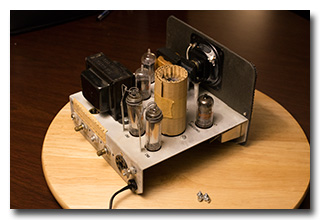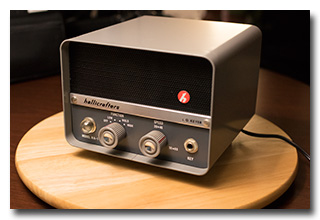
by William Eric McFadden
From the manual:
-
1.1. DESCRIPTIONThe Hallicrafters Model HA-1 T.O. Keyer® employs digital circuitry, similar to that found in modern digital computers, to form perfect code characters at any speed. Experienced operators appreciate its stability and precision of operation, and novice operators discover a new command of CW that leads to proficiency and unsuspected enjoyment. The keyer operates much in the same way as a tape transmitter; the dash-dot and mark-space ratios remain constanct over the speed range, and the speed and mark-space adjustments are completely independent.The key lever is a remove control unit that may be placed in any convenient operating position. This conserves the operating area, permits ready mechanical adjustments, and allows the operator his choice of key levers.Additional features of the keyer include a pleasant sidetone signal with volumne control for practice, instruction or monitoring... an exceptionally wide speed range... a silent mercury-wetted relay of virtually unlimited life... complete immunity to line-voltage fluctuations and RF pickup... rear connections for break-in operation and auxillary control, and for external sidetone and key lever connections... and a transformer power supply, with silicon recifiers and complete voltage regulation for top reliability.1.2. STANDARDS FOR THE INTERNATIONAL MORSE CODEThe International Morse code replaced the older Morse code for radio communications when the tape perforator and keying head, along with the high-speed ink-slip recorder, we developed for commercial service. This early automation of our CW is still widely employed, handling traffic comfortably at 300 WPM. The perforator and the keying head provide the "perfect fist" and the standards for CW which make it easy to send and receive with the proper scientific economy.The relative duration of the dot and the space is called the mark-space ratio, usually adjusted for 1-to-1. A dash is formed by bridging the space between two dots. The spaces between dots and dashes in a letter are uniform. A standard word is equivalent to 24 dots and spaces. 10 WPM (words per minute) is therefore 240 dots per minute, or 4 dots per second.
SPECIFICATIONS: POWER SOURCE 105 to 125 volts, 60 cycles AC, 25 watts SPEED RANGE Low: 10 to 30 WPM.
High: 25 to 65 WPM.KEYING MONITOR Self-contained tone generator and PM speaker. Rear chassis mounted PHONES jack disconnects speaker when phones are inserted TRANSMITTER KEYING Mercury-wetted contact relay switching normally open or normally closed to ground. KEY LEVER INPUT Three-circuit jack mounted on front panel accepts 1/4 inch diamter (Switchcraft type 267 or equivalent) or rear control outlet connections. CONTROL OUTLET Eight-pin octal socket mounted on rear panel accepts standard octal plug (supplied) DIMENSIONS OVERALL) 5-5/8 inches x 7 inches x 7-13/16 inches (HWD) NET WEIGHT 7-1/2 pounds SHIPPING WEIGHT 10 pounds
 I acquired my very clean Hallicrafters HA-1 "T.O." Keyer at Hamvention 2017 to use with my
Drake 2-NT CW transmitter.
I acquired my very clean Hallicrafters HA-1 "T.O." Keyer at Hamvention 2017 to use with my
Drake 2-NT CW transmitter.
Examination of the keyer after I got it home has led me to wonder if the keyer has ever been powered up—the corrugated-paper sleeve is still on the mercury-wetted relay and the power plug doesn't show any signs of ever having been inserted into a AC socket.
As of the time of this writing, I have not yet applied power to the keyer, nor have I looked into building the interface to connect it to my Drake 2-NT. I hope to do initial power-up soon using my "dim bulb tester".
If the HA-1 "T.O." Keyer isn't a twin of the Hallicrafters HA-5 VFO, the two are surely very close siblings. The pair look very nice bracketing my Drake 2-C and 2-NT, with the "T.O." Keyer on the left and the VFO on right right. (I had intended to place both units to the right of the 2-C and 2-NT but when I compared my HA-5 VFO to the HA-1 Keyer, it became immediately apparent that a previous owner had repainted the VFO's cabinet a slightly different shade of gray.)
I will update this page with more comments about the "T.O." Keyer after I've used it for a while.
